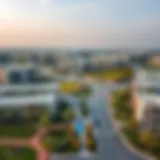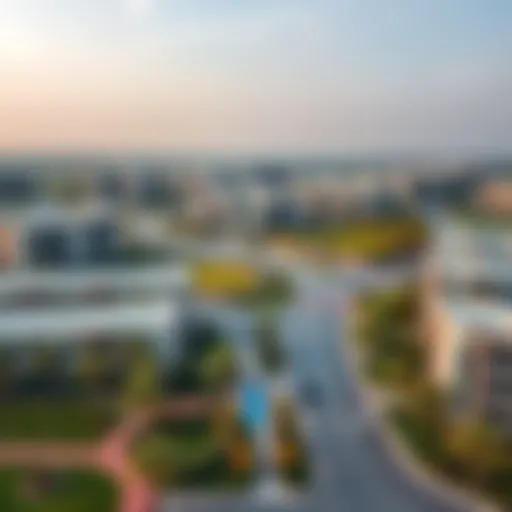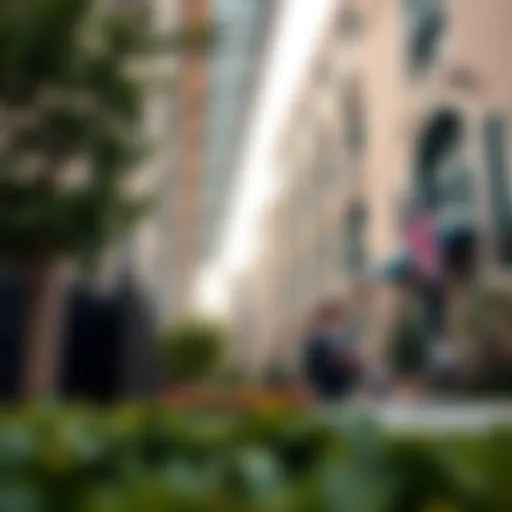Exploring Dubai's Parks: Oasis in Urban Life
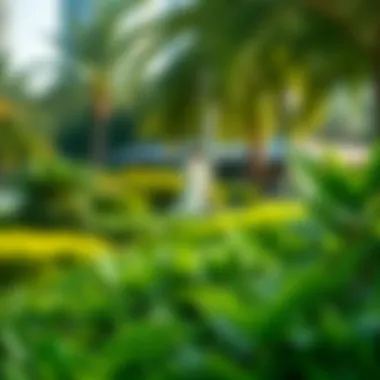

Intro
In a city characterized by its towering skyscrapers and sprawling urban development, parks in Dubai offer a refreshing contrast, creating pockets of greenery that play a vital role in enhancing the quality of life. These green spaces not only serve as recreational havens for residents but also contribute significantly to the ecological balance in an ever-expanding metropolis. As an investor, property manager, or a developer, understanding the nuances of these parks and their integration into the urban landscape can provide invaluable insights into potential opportunities for growth and sustainability.
The significance of parks often goes unnoticed amid the hustle and bustle of urban life. Yet, they serve as crucial components of urban infrastructure, providing residents with a much-needed escape from the concrete jungle. The beautifully designed parks foster community interactions, promote physical activity, and support diverse ecosystems, thus underlining the essential role they play in urban living.
In this discussion, we will explore the various aspects of parks in Dubai, drawing attention to their design features, the services they provide to the ecosystem, and their broader community impact. We’ll delve into the current challenges of maintaining these vital spaces in a rapidly urbanizing landscape, and examine future growth opportunities that lie ahead. By shedding light on these green oases, we aim to enhance understanding of their value, not just to residents but also to investors looking for sustainable ventures in a constantly evolving city.
Preface to Parks in Dubai
Parks in Dubai play a crucial role in transforming the urban experience into something more livable, vibrant, and connected to nature. As the city continues to expand at a breakneck pace, the significance of these green spaces cannot be overstated. They offer a respite from the hustle and bustle and serve not only as recreational areas but also as vital components of the urban ecosystem. For investors, property managers, and developers, understanding the value of parks is paramount when considering the overall attractiveness of residential and commercial projects.
Historical Context
Historically, Dubai was primarily known for its trading routes and trade centers rather than its greenery. However, as the emirate modernized in the latter half of the 20th century, a conscious effort was made to integrate green spaces into the burgeoning urban landscape. Early parks such as the Dubai Creek Park were initiated in the 1970s, empowering citizens to engage with nature while promoting social interaction. This historic backstory illustrates how green spaces have evolved from being mere afterthoughts to essential urban planning elements that preserve a slice of nature within the concrete sprawl.
As you wander through these parks, you’ll notice remnants of a time where natural beauty was scarce. It’s fascinating how Dubai's leadership recognized the need for parks as the city expanded. Investing in these areas has not only enriched the quality of life but has also enhanced property values and attracted expatriates, ensuring that parks remain a focal point in Dubai's future planning endeavors.
Modern Urbanization and Green Spaces
Today, the contrast between skyscrapers and lush green parks is emblematic of Dubai’s urban identity. Modern urbanization poses challenges, but it also presents opportunities for innovative landscaping and design. The Dubai government has embraced this challenge by implementing strategic plans to create and maintain green spaces amid rapid development. Parks have become essential not just for recreation but also for addressing environmental issues, such as air quality and biodiversity.
In recent years, projects aimed at enhancing existing parks, adding new ones, and promoting sustainability practices have taken center stage. One notable initiative is the Dubai 2040 Urban Master Plan, which envisions a city filled with green spaces, aiming to increase park land and gardens. This ambitious vision recognizes the need for a balanced environment where urban life can thrive alongside nature.
"An investment in parks is an investment in humanity; it enhances the quality of life for both residents and visitors alike."
The intertwining of modern architecture with carefully curated parks fosters a community-oriented atmosphere. Parks are not distant green patches anymore; they are central to neighborhood designs. This focus caters to the needs of diverse demographics, presenting an excellent opportunity for developers to market properties that boast proximity to these idyllic spaces. Ultimately, the integration of parks into urban life reaffirms Dubai's commitment to nurturing a sustainable future.
Major Parks in Dubai
In a bustling city like Dubai, where skyscrapers and commercial zones dominate the horizon, the significance of major parks becomes increasingly crucial for both residents and visitors. These green spaces act as oases within the urban jungle, providing not just a visual contrast but also a range of benefits that enhance the quality of life. From recreational opportunities to natural ecosystems, each park plays a distinct role in fostering community connections and promoting environmental health.
Dubai Creek Park
Dubai Creek Park, sprawling along the shores of the historic Dubai Creek, is one of the oldest and most cherished parks in the city. This sprawling area stretches over 96 hectares and serves as a natural refuge for those seeking respite from the city’s fast pace. The park is designed with lush landscaped gardens and walking paths that encourage outdoor activity.
Visitors often enjoy picnics in large open areas while children can be found gleefully playing in playgrounds. An attraction here is the Dubai Dolphinarium, where one can indulge in an up-close encounter with dolphins.
"Dubai Creek Park stands at the intersection of nature and city life, showcasing the importance of preserving green space amidst ongoing development."
Al Safa Park
Al Safa Park, located close to the bustling Sheikh Zayed Road, is another gem that offers diverse recreational options. The park’s design incorporates a mix of sports facilities and walking trails, making it a hotspot for fitness enthusiasts. With its vast green expanses, Al Safa is perfect for jogging, cycling, and even yoga sessions as it promotes physical well-being.
Additionally, the park's proximity to major art galleries helps to create a cultural hub, where community events and art exhibitions regularly take place. The serene surrounding makes Al Safa an ideal choice for those looking to unwind while still being connected to vibrant urban culture.
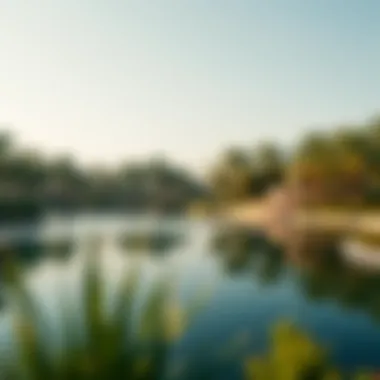

Zabeel Park
Zabeel Park is often regarded as the heartbeat of Dubai's green zones. Encompassing around 47 hectares, the park is known for its innovative designs which showcase environmental sustainability and technological integration. The park is equipped with a solar energy-powered Wi-Fi network, promoting eco-friendly practices.
Its unique features like the Dubai Frame—a breathtaking architectural marvel—provide picturesque views of both old and new Dubai. Zabeel Park also lays claim to an amusement zone and has dedicated spaces for food and events, which invite people from all walks of life to gather and connect.
Jumeirah Beach Park
Lastly, Jumeirah Beach Park offers another layer to the park experience in Dubai. This park is not just about greenery; it also offers direct access to one of the city's most popular beaches. The blend of sandy shores with well-maintained gardens creates a captivating environment for beachgoers and park visitors alike.
Families flock to Jumeirah Beach Park for its barbecue areas and shaded picnic zones. With children’s playgrounds and sports facilities such as volleyball courts, it has something to offer for everyone. Just a stone’s throw away from the beach, it affords a rare perfect combination of sun, sea, and serene green scenery.
Each of these parks contributes uniquely to the urban landscape of Dubai, making them essential for maintaining a harmonious balance between nature and city life. As the city expands, understanding the role of these green spaces becomes critical for the well-being of its inhabitants.
Design and Features of Dubai Parks
The design and features of parks in Dubai play a pivotal role in enhancing the urban environment. Given the rapid urban expansion in this desert metropolis, the thoughtful incorporation of green spaces is essential. Instead of being mere afterthoughts amid the steel and concrete, Dubai's parks serve as vibrant corners of nature, offering not just aesthetics but also significant environmental benefits. Investors and developers keen on property in the vicinity must recognize how these parks add value and appeal to their projects.
Landscaping Innovations
Innovative landscaping has become a hallmark of Dubai's parks. From the clever use of native plants to intricate water features, designs reflect a deep understanding of the local climate and ecology. For example, Dubai Miracle Garden showcases a stunning array of flowers arranged in unique shapes, making it a visually captivating experience. The strategic choice of drought-resistant flora ensures that irrigation is minimal, thereby conserving water, which is a crucial resource in the region.
- Native Flora Utilization: By using local plants, parks reduce maintenance costs and enhance biodiversity.
- Sustainable Water Features: Features like ponds and fountains not only provide visual interest but also help with temperature regulation.
- Artistic Layouts: Paths and seating areas are often creatively integrated into the landscape, encouraging leisurely strolls and moments of relaxation.
Such innovations do not just beautify spaces; they bolster environmental resilience and promote a sense of community among the throngs of visitors.
Recreational Facilities
Another significant aspect of Dubai's parks is their recreational facilities. These spaces are designed not merely for relaxation but also for active engagement. Sports fields, playgrounds, and fitness stations populate these parks, encouraging healthy lifestyles. Al Safa Park, for instance, features running tracks surrounded by lush greenery, creating a serene environment conducive to exercise.
- Diverse Options: From basketball courts to tranquil yoga spots, facilities cater to a wide range of interests.
- Family-Friendly Amenities: Children's play areas designed with safety and creativity in mind enhance family visits.
- Event Spaces: Many parks are equipped to host social events or community gatherings, thus reinforcing social ties within neighborhoods.
These amenities ensure that parks become essential hubs for both residents and tourists, adding richness to urban life.
Sustainability Practices
Sustainability in park design is not just a trend; it’s a pivotal aspect of planning in Dubai. The city recognizes that parks can help mitigate urban heat and reduce carbon footprints. Various parks have integrated sustainable practices into their frameworks. For example, Zabeel Park employs solar-powered lighting to reduce electricity consumption.
Key practices include:
- Water Conservation: Implementing smart irrigation systems that minimize water use while maintaining lush landscapes.
- Waste Management Initiatives: Effective recycling programs in parks educate the public on sustainability while also reducing landfill waste.
- Organic Maintenance: Using organic fertilizers and pest control methods to preserve the health of the ecosystem.
By placing a solid emphasis on sustainability, Dubai's parks do more than just beautify the city; they serve as models of ecological responsibility.
"Parks in Dubai are designed not just for beauty but for utility, blending luxury with sustainability in a unique dance of nature and design."
Overall, the design and features of parks in Dubai reflect a forward-thinking approach—a blend of innovation, recreation, and sustainability that makes these green spaces invaluable to the urban landscape.
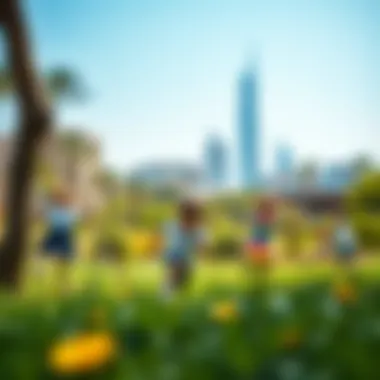

The Role of Parks in Community Well-being
Parks have long been seen as the lungs of a city. They act as open spaces that not only beautify urban landscapes but also provide a myriad of benefits to the community. In the context of Dubai, as the city continues to grow and develop, the role of these green spaces assumes an even greater significance. By examining the physical health benefits, mental wellness, and opportunities for cultural engagement, one can appreciate how parks contribute to the overall well-being of individuals and communities alike.
Physical Health Benefits
One of the most immediate advantages of parks is their impact on physical health. Having access to green spaces encourages people to be active. Rather than spending hours cooped up indoors, individuals can immerse themselves in outdoor activities like jogging, cycling, or simply walking. The availability of facilities like jogging tracks, tennis courts, and fitness stations in parks across Dubai fosters an active lifestyle.
- Promotes Exercise: Parks provide a natural setting for exercise, making it more appealing and accessible.
- Encourages Social Interaction: Group sports and fitness classes create a community atmosphere, fostering social bonds.
- Improves Air Quality: Trees and plants in parks help purify the air, contributing to physical health by reducing pollution-related illnesses.
Research has shown that regular activity lowers the risk of chronic illnesses such as obesity, diabetes, and cardiovascular diseases. In a city like Dubai, where the summer heat can be stifling, shaded parks offer a respite, allowing residents to maintain an active lifestyle year-round.
Mental Health and Recreation
Beyond the physical benefits, parks hold immense potential for enhancing mental health. They serve as tranquil retreats from the hustle and bustle of city life, allowing individuals to unwind and recharge. It has been said that nature has a soothing effect; this isn’t just an old wives’ tale. Studies confirm that exposure to green spaces reduces stress and anxiety levels.
- Stress Relief: Spending time in parks can lower cortisol levels, leading to improved emotional health.
- Aesthetic Enjoyment: The beauty of well-maintained parks can uplift moods and enhance quality of life.
- Mindfulness and Relaxation: Parks offer quiet spots for meditation, reading, or simply enjoying the outdoors, which can aid in cultivating mindfulness.
For many, parks also encourage hobbies like photography, birdwatching, or gardening, further enriching their mental well-being. Parks can be sanctuary spaces where communities come together in harmony, fostering relationships that are crucial for emotional support.
Cultural Events and Social Gatherings
Parks in Dubai aren’t just places for physical activity and relaxation; they are also vital cultural hubs that facilitate social gatherings and community events. The integration of cultural festivals, art exhibitions, and music events into park spaces helps to strengthen community bonds.
- Cultural Celebrations: Parks can host events like the Dubai Shopping Festival, where the community comes together to celebrate.
- Social Cohesion: Open-air cinemas, markets, and food festivals create opportunities for people to mingle and connect.
- Inclusive Spaces: Parks serve as venues accommodating diverse cultures and backgrounds, promoting unity and understanding.
"Parks symbolize community spirit; they celebrate our diversity while fostering connection."
Furthermore, the emphasis on community-driven events in parks means that local residents can share their traditions, celebrate festivals, and even introduce their culinary arts, enriching the urban fabric and creating a shared sense of belonging.
In summary, the parks of Dubai do not merely serve as patches of greenery in an urban setting. They are essential for enhancing physical health, nurturing mental wellness, and providing platforms for cultural exchange. These elements play a crucial role in improving the quality of life for residents and visitors alike.
Challenges Facing Dubai's Parks
The evolution of Dubai's parks is a testament to the city’s ambition to integrate green spaces into a bustling urban environment. However, this development does not come without its hurdles. As more land is repurposed for construction and development, several challenges put parks at risk. Understanding these challenges is essential not only for preserving these green areas but also for enhancing urban life in Dubai. The continued success and enhancement of these parks fundamentally rely on addressing three primary issues: urban development pressures, environmental concerns, and maintenance along with funding issues.
Urban Development Pressures
In the relentless march of urbanization, parks often find themselves squeezed between high-rise buildings and commercial developments. As land becomes increasingly scarce in this booming metropolis, park spaces can sometimes seem like the last piece of real estate worth developing. Expansions in residential and commercial properties threaten to overshadow these vital green areas.
For instance, the recent push to build more luxury apartments has led to proposals for repurposing small parks into upscale facilities. This not only limits public access but also diminishes the overall quality of life in the neighborhoods they serve. The demand to maximize land utility often leads urban planners to overlook the fundamental benefits parks provide, such as recreational spaces, biodiversity, and a cooling urban environment.
Preserving green spaces against urban development is thus not merely a challenge; it is an urgent need. Stakeholders must advocate for stronger policies that recognize the essential role green areas play in urban design. Through concerted efforts, there's potential for a balanced approach—one that fosters growth while safeguarding the existing green landscape.
Environmental Concerns
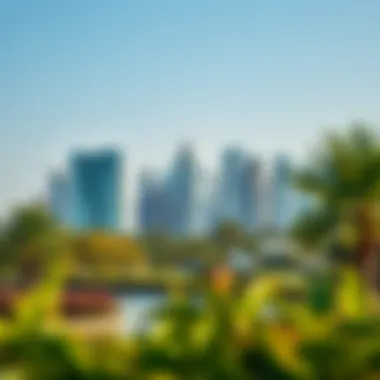

Beyond the sheer pressure of development, environmental issues pose significant threats to Dubai’s parks. Climate change and its associated effects, like rising temperatures and decreased rainfall, directly influence the vitality of these green spaces. Efforts to sustain healthy ecosystems often run into trouble due to these external factors. Increased heat significantly affects flora species; some plants simply cannot withstand prolonged temperature spikes. Furthermore, invasive plant species can take hold, disrupting local ecosystems and further compromising the parks' integrity.
The management practices must adapt rapidly to these shifting environmental conditions. A more innovative and ecologically sensitive approach is required to ensure the parks survive and thrive amidst climate vulnerabilities. Programs designed to combat erosion and enhance biodiversity can eventually yield better results for both the parks and the community.
Maintenance and Funding Issues
Lastly, the sustainability of parks in Dubai largely hinges on adequate maintenance and funding. With the growth of urban spaces, it is vital that parks are not seen as secondary areas but as integral parts of the community. Maintenance involves more than just grass cutting; it requires ongoing investment in infrastructure, amenities, and landscape health. Without proper funding, parks can fall into disrepair, losing their attractiveness and utility for residents.
Moreover, public funding may not always cover the total maintenance costs. Many parks often rely on private sponsorship or initiatives to support their upkeep, leading to disparities in quality among different parks. This raises important questions for community leaders and investors about who is responsible for ensuring that all parks remain functional and welcoming.
Addressing these funding challenges is crucial for sustaining the benefits of green spaces. For instance, identifying sponsorships or implementing park entrance fees could open new avenues for maintaining the existing green areas.
As we look ahead, it is clear that addressing these challenges is not only important for the parks themselves but also for the overall health and well-being of Dubai's communities. By overcoming these barriers, the city can cultivate a rich tapestry of parks that enhance the urban environment while providing valuable social, physical, and mental benefits to its residents.
Future of Parks in Dubai
The future of parks in Dubai stands as a topic of great importance in this discussion about urban green spaces. With the rapid urbanization that this city continues to experience, the necessity of developing and maintaining parks grows even stronger. These spaces are not merely aesthetic additions to the skyline; they are becoming essential to the quality of life for residents. Addressing environmental concerns and fostering community well-being are paramount next steps in ensuring that these green areas continue to thrive amidst concrete and steel.
Upcoming Green Projects
Dubai is not sitting idle when it comes to enhancing its green spaces. Numerous green initiatives are underway or on the drawing board, aimed at improving the quantity, accessibility, and quality of its parks. One prominent project includes the Dubai Urban Forest, where plans are in full swing to plant thousands of trees across the city, integrating flora into the urban fabric.
Another noteworthy venture is the expansion of Mushrif Park, which focuses on promoting biodiversity by incorporating native plants that are well suited for the local climate. As plans like these materialize, they are likely to involve several amenities—think cycling paths, walking trails, and recreational areas meant for various community activities. The impact of these projects cannot be overstated; they help create cooler microclimates, and encourage biodiversity, and facilitate community interactions—all vital components of urban life.
Enhancements in Urban Planning
The integration of parks in urban planning is essential. Dubai’s urban planners are increasingly recognizing the need to incorporate greenery into their designs, understanding that parks can effectively counterbalance urban density. This shift can be seen in the establishment of mixed-use developments that seamlessly blend residential, commercial, and recreational spaces.
For instance, The Dubai Waterfront project is a prime example where high-rise living meets sprawling green spaces. The focus is on creating pedestrian-friendly environments with easy access to parks, encouraging the populace to enjoy the outdoors more frequently. This strategic thinking not only nurtures the environment but also promotes a healthier lifestyle among residents. As these planning methods evolve, we can expect the parks of Dubai to become central to urban fabric, rather than being odd pockets scattered throughout the city.
Community Involvement and Input
Engaging community members in the planning and upkeep of parks is key. Local residents can offer valuable insights into their needs and preferences, fostering a sense of ownership and pride. Dubai has started to take steps towards this proactive approach by organizing community forums, where citizens can voice their opinions on park improvements and express what facilities they want to see.
Moreover, volunteer programs are gaining momentum, allowing community members to participate directly in maintenance activities and planting events. These initiatives not only beautify the parks but also strengthen social ties. In a bustling place like Dubai, where a diverse population resides, cultivating this community spirit through involvement in local parks is an integral aspect of preserving the city’s identity.
"The future depends on what you do today." – Mahatma Gandhi
See more on these topics at: Dubai Municipality or explore more insights on environmental sustainability through UN Environment Programme.
Finale
In summing up the significance of parks within the urban tapestry of Dubai, it's essential to recognize them as not merely patches of greenery but as vital components of the city’s ecosystem. These parks serve multiple purposes, enriching the lives of residents and visitors alike while fostering an atmosphere of community and health. The balance between bustling urban life and serene green spaces is crucial for enhancing quality of life.
Summary of Key Points
Throughout this exploration, several key elements have emerged:
- Historical Context: Dubai’s evolution from arid landscapes to a city filled with parks demonstrates a commitment to enhancing urban living and sustainability.
- Major Parks: Highlighting parks like Dubai Creek Park, Al Safa Park, and Zabeel Park showcases the diversity found within these green spaces, each offering unique features and attractions.
- Design Innovations: The focus on landscaping and sustainable practices highlights how parks are designed with intention, considering environmental impact and user engagement.
- Community Benefits: Parks contribute to physical fitness, mental well-being, and foster cultural events, enriching community life.
- Future Directions: Upcoming projects emphasize the continuous improvement of park infrastructure and community involvement, showing that the city plans to expand and adapt its green spaces to meet growing needs.
Final Thoughts on Green Spaces
As we look ahead, it becomes clear that green spaces are pivotal in urban planning and development strategies. They are not just an afterthought but rather a deliberate choice in shaping a livable city. The importance of these parks cannot be understated, as they provide sanctuary from the urban rush, promote healthy lifestyles, and act as venues for social connections. For stakeholders—investors, property managers, and developers—the integration of green spaces in urban projects should be a priority. Such considerations lead to not only enhanced property value but a happier, healthier community.
